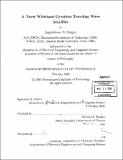A novel wideband gyrotron travelling wave amplifier
Author(s)
Sirigiri, Jagadishwar R. (Jagadishwar Rao), 1973-
DownloadFull printable version (19.26Mb)
Other Contributors
Massachusetts Institute of Technology. Department of Electrical Engineering and Computer Science.
Advisor
Richard J. Temkin.
Terms of use
Metadata
Show full item recordAbstract
We present the design and the experimental results of a novel wideband quasioptical Gyrotron Traveling Wave Tube (gyro-TWT) amplifier and the first Vacuum Electron Device (VED) with a Photonic Band Gap (PBG) structure. The theory and experimental results from two other quasioptical gyrotron oscillator experiments are also presented. The gyro-TWT amplifier at 140 GHz produced up to 30 kW of peak power in operation with 3 ts pulses at 6 Hz, 2.30 GHz unsaturated bandwidth, a peak linear gain of 29 dB and an efficiency of 12 %. This is the highest frequency gyro-TWT reported as yet. The use of a very high order operating mode in a novel mode selective interaction structure namely, a quasioptical open confocal waveguide makes the gyro-TWT potentially capable of up to 100 kW CW operation at 140 GHz and at 94 GHz in the W-band (75-110 GHz) if built to industrial standards. The theory and experimental results from the first VED with a PBG resonator, in the form of a high power high frequency gyrotron oscillator at 25 kW power level at 140 GHz in a high order mode, TE041 are also presented. The absence of any spurious mode excitation over 30 % variation in the magnetic field corresponding to an equal variation in the cyclotron frequency indicates that the PBG resonator was highly mode selective while operating in a higher order mode. This opens up promising avenues for building highly oversized resonators for generating Terahertz radiation with low voltage electron beams. (cont.) The successful operation of this high frequency gyrotron suggests that overmoded PBG resonators can also be used in conventional slow-wave devices to build moderate power (few hundreds of Watts) VEDs in the millimeter and sub-millimeter wave regime for a variety of applications. A gyrotron oscillator experiment with an overmoded open confocal resonator was also run at a peak power of up to 83 kW at 136 GHz with an efficiency of 16 %. The gyrotron oscillator experiment had excellent mode stability which makes an oversized quasioptical open confocal resonator a candidate for use in high frequency millimeter and sub-millimeter wave gyrotrons. A second harmonic confocal gyrotron experiment was also tried at 280 GHz but the poor quality electron beam prevented the generation of the second harmonic, however, the stronger fundamental mode interaction was suppressed thus validating the advantages of using confocal resonators in high harmonic gyrotrons to suppress the stronger fundamental interaction. The experiments on three millimeter wave VEDs with two novel kinds of highly oversized interaction structures described in this work have demonstrated a novel technique for building high power (> 1 kW) high frequency (> 100 GHz) VEDs.
Description
Thesis (Ph. D.)--Massachusetts Institute of Technology, Dept. of Electrical Engineering and Computer Science, 2003. Includes bibliographical references (leaves 193-214).
Date issued
2003Department
Massachusetts Institute of Technology. Department of Electrical Engineering and Computer SciencePublisher
Massachusetts Institute of Technology
Keywords
Electrical Engineering and Computer Science.